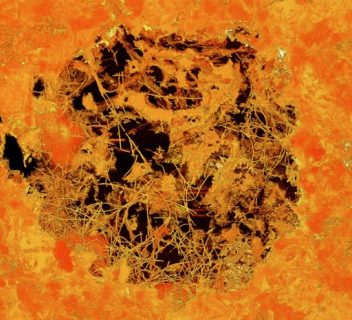
by Marlowe Hood
Agence France Presse
PARIS, France (AFP) — Fossils accidentally discovered in South Africa are probably the oldest fungi ever found by a margin of 1.2 billion years, rewriting the evolutionary story of these organisms which are neither flora nor fauna, researchers said Monday.
If verified as both fungal and multicellular, the 2.4 billion-year-old microscopic creatures — whose slender filaments are bundled together like brooms — could also be the earliest known specimens of the branch of life to which humans belong, they reported in the journal Nature Ecology & Evolution.
Up to now, the first fossil trace of eukaryotes — the “superkingdom” that includes plants, animals and fungi, but not bacteria — dates to only 1.9 billion years ago.
Earth itself is about 4.6 billion years old.
The ancient fungus-like life forms, found in fossilized gas bubbles 800 meters (2,600 feet) underground in South Africa’s Northern Cape Province, are remarkable not just for their age but their origin, the researchers said.
It has long been assumed that fungi first emerged on land, but the newly-found organisms lived and thrived under an ancient ocean seabed, tucked in the crevices of volcanic rock.
Nobody was looking for them, explained co-author Birger Rasmussen, a geology professor at Curtin University in Bentley, Australia who was examining lava samples from the Ongeluk Formation to determine their age.
It screamed ‘life’
“My attention was drawn to a series of petrified gas bubbles, and when I increased the magnification of the microscope, I was startled,” he recalled.
The bubbles were “filled with hundreds of exquisitely preserved filaments that just screamed ‘life’,” he wrote by email.
The plot thickened when Rasmussen realized that the surrounding lava was not 2.2 billion years old, as previously thought, but 2.4 billion years old.
That extra 200 million years was significant because it straddles a critical threshold in Earth’s geological history called the Great Oxidation Event — a rapid and massive outpouring of oxygen into the atmosphere.
The new dating meant that not only had these fungus-like creatures lived in a dark and cavernous world devoid of light, but they also lacked oxygen.
“This would have tremendous implications for the lifestyle of the early ancestors of eukaryotes and fungi,” Rasmussen added.
For many years, fungi were grouped with, or mistaken for plants. Not until 1969 were they officially granted their own “kingdom,” alongside animals and plants, though their distinct characteristics had been recognized long before that.
Yeast, mildew and molds are all fungi, as are many forms of large, mushroom-looking organisms that grow in moist forest environments and absorb nutrients from dead or living organic matter.
Looking in the wrong place
Unlike plants, fungi do not photosynthesize, and their cell walls are devoid of cellulose.
The creatures unveiled in the new study existed in what is called the deep biosphere, beneath land and sea.
“The deep biosphere — which hosts a significant part of Earth’s biomass — is very poorly known, and its history even more so,” said lead author Stefan Bengtson, a palaeobiologist at the Swedish Museum of Natural History.
Earlier research has turned up evidence that gas bubbles in lava below the bottom of the sea provided living space for fungi as far back as 50 million years.
“What we have now found is that such a habitat existed already more than two billion years ago — at a time when fungi were not thought to have yet existed,” Bengtson told AFP.
Fungi in this environment most probably live in symbiosis with microbes, using chemically stored energy for their metabolism, added co-author Magnus Ivarsson, an expert on these hidden worlds.
“They may not even have needed free oxygen.”
Scientists not involved in the study said its was potentially paradigm shifting, but must be bolstered by further research.
The discovery “challenges current thinking about when and where eukaryotes evolved,” Nicola McLoughlin, a professor at Rhodes University in Grahamstown, South Africa, commented, also in Nature Ecology & Evolution.
It “raises the question of whether we have been looking in the wrong place for the earliest eukaryotes and fossil fungi in particular.”








